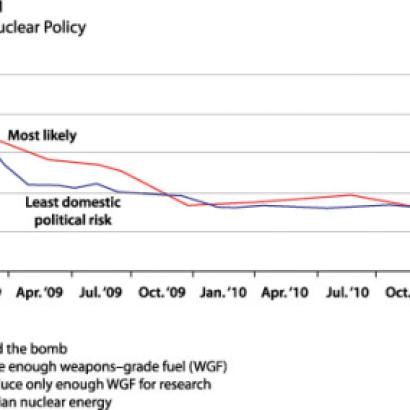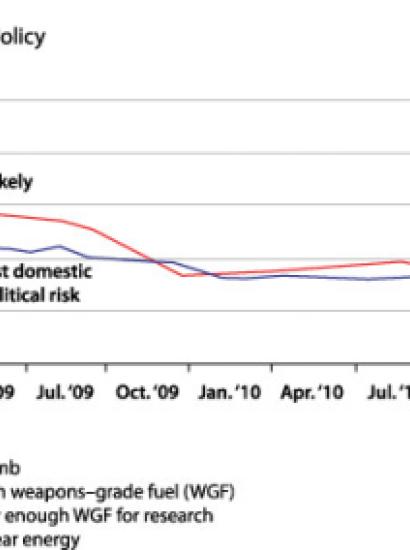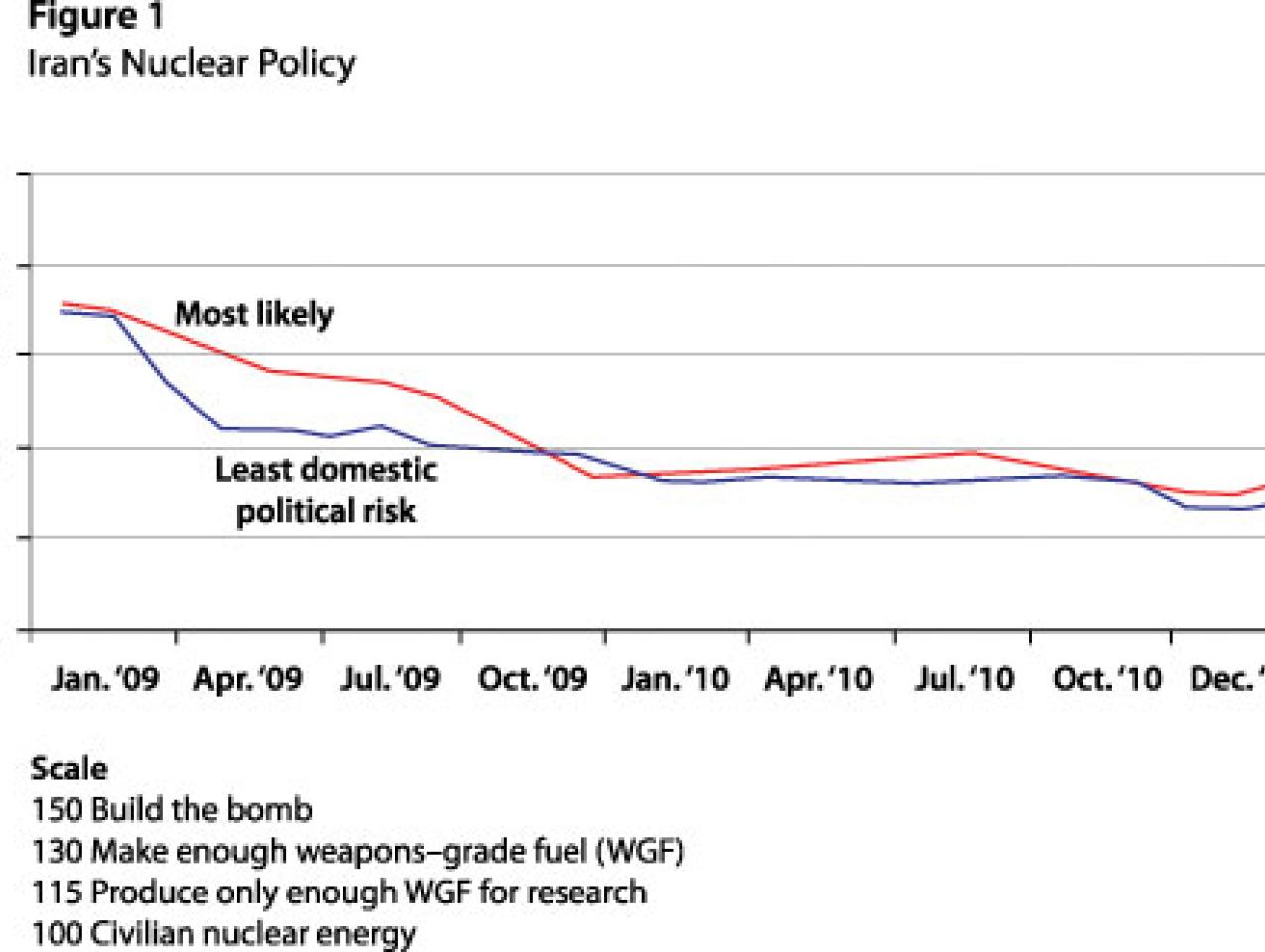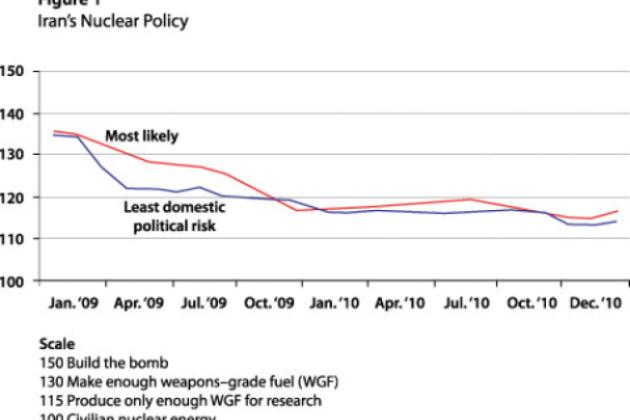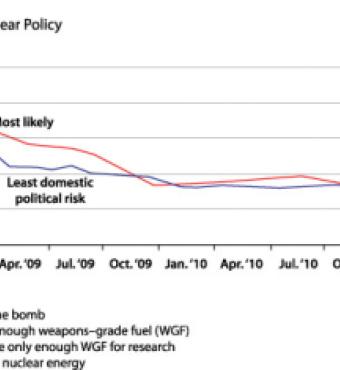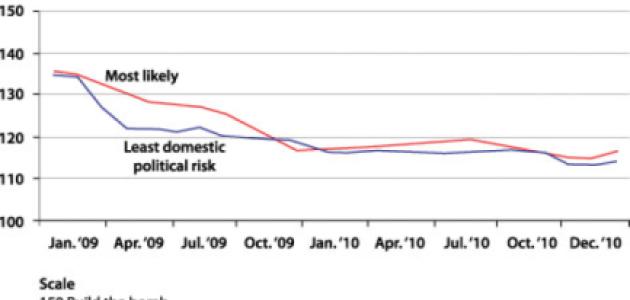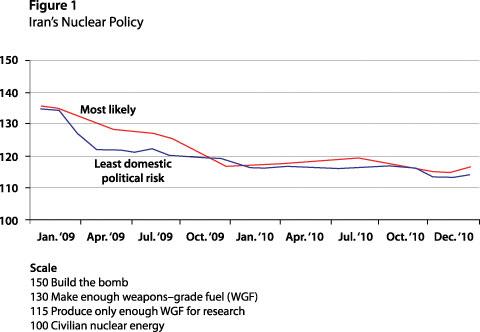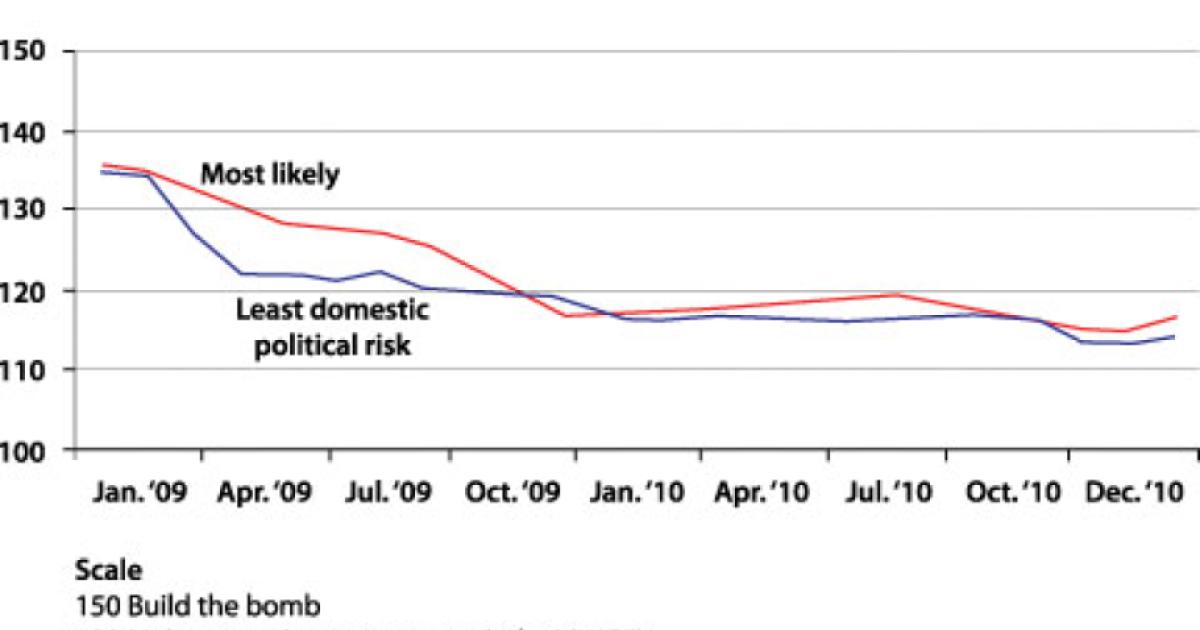- International Affairs
- US Foreign Policy
- Security & Defense
- US Defense
- Terrorism
- Energy & Environment
Hoover senior fellow Bruce Bueno de Mesquita described his work in game theory at the TED2009 conference (TED stands for technology, entertainment, and design) held February 7 in Long Beach, California. The Economist, reporting on the gathering, said Bueno de Mesquita deserved the event’s “putting your money where your mouth is” prize for his predictions about Iran and its nuclear program. “If all this comes to pass,” wrote the newsmagazine, “remember: TED heard it first.” Highlights of the talk:
What I’m going to try to do is explain how to predict, and quickly illustrate it with some predictions, what Iran is going to do in the next couple of years.
To predict effectively, we need to use science, because we can then reproduce what we’re doing and not rely on wisdom or guesswork. And if we can predict, then we can engineer the future. So if you are concerned about influencing energy policy, or national security policy, or health policy, or education, then science—and a particular branch of science—is a way to do it. This is not the way we’ve been doing it, which has been by using seatof- the-pants wisdom.
Now before I get into how to do it, let me give you a little truth in advertising, because I’m not engaged in the business of magic. There are lots of things that the approach I take can predict, and there are some that it can’t.
It can predict complex negotiations or situations involving coercion—in essence everything that has to do with politics and much of what has to do with business—but sorry, if you’re looking to speculate in the stock market, I don’t predict stock markets. (OK, it’s not going up any time really soon.) I’m also not involved in predicting random-number generation. I actually get phone calls from people who want to know which lottery numbers are going to win. I don’t have a clue.
I use game theory. It’s a branch of mathematics, which means that even in the study of politics, math has come into the picture. We can no longer just speculate about politics; we need to look at it in a rigorous way.
Now, what is game theory about? It assumes that people are looking out for what’s good for them. That doesn’t seem terribly shocking, although it bothers a lot of people that we are self-interested. To look out for what’s best for them, or what they think is best for them, people have values. They identify what they want and what they don’t want, and they form beliefs about what other people want and what other people don’t want, about how much power other people have, and about how much those people can get in the way of whatever it is that they want.
And they face limitations, constraints. They may be weak, they may be located in the wrong part of the world, they may be a genius stuck away farming someplace in a rural village in India not being noticed, as was the case for Srinivasa Ramanujan, the celebrated natural mathematician.
A lot of people worry about the assumption of rationality. “People aren’t really rational,” they say. I disagree. Mother Teresa was rational; terrorists are rational; pretty much everybody is rational. I can think of only two exceptions: two-year-olds and schizophrenics. But the rest of us are trying to do what we think is in our own best interest.
If you’re trying to influence corporations to change their behavior about producing pollutants, one approach (a common one) is to exhort them to be better, to explain to them how they’re damaging the planet. Many of you may have noticed that this doesn’t have a big effect. If you show corporations that cleaning up is in their interest, however, they become more responsive. To work out what people are going to do to pursue their interest, we need to think about who it is that holds influence in the world.
ONLY COMPUTERS CAN SORT IT ALL OUT
We would like to think that the president of the United States has some influence on the actions of Iran, for example. Certainly the president of Iran has influence. But if we pay attention only to the person atop the power ladder, such as the U.S. chief executive, that person might not know much about Iran, or energy policy, or health care, or any particular policy. That person surrounds himself with advisers. Regarding national security problems, maybe it’s the secretary of state, the secretary of defense, the director of national intelligence . . . it might be the ambassador to the United Nations or somebody else who is assumed to know something of the particular problem. But let’s face it—the secretary of state doesn’t know much about Iran; the secretary of defense doesn’t know much about Iran. Those people also have advisers who advise them so they can advise the president. Lots of people end up shaping decisions. And so if we want to predict correctly, we have to pay attention to everybody who is trying to shape the outcome—not just those at the pinnacle of the decision-making pyramid.
Unfortunately, we often fail to do that because the problem rapidly becomes complicated, as I’ll demonstrate. Imagine a problem with just five decision makers. Imagine, for example, that Sally over here wants to know what Harry and Jane and George and Frank are thinking, and sends messages to those people. Sally is giving her opinion to them, and they’re giving their opinions to Sally. But Sally also wants to know what Harry is saying to the three others and what they’re saying to Harry. And Harry wants to know what each of those people is saying to each of the others, and so on. That’s a lot to know. With five decision makers, there are a lot of linkages: 120, as a matter of fact, if you remember your factorials; five factorial is 120. You may be surprised to know that smart people can keep 120 things straight in their head.
But suppose we double the number of influencers from five to ten. Does that mean we’ve doubled the number of pieces of information we need to know, from 120 to 240? No. How about ten times, to 1,200? No. We have increased the pieces of information to 3.6 million. Nobody can keep that much straight in her head—but computers can. They don’t need coffee breaks or vacations or a good night’s sleep. They don’t ask for raises, either. They can keep this information straight, meaning that we can process the information.
What do we need to know, in order to predict? Not very much, actually. We need to know who has a stake in trying to shape the outcome of a decision. We need to know what they say they want—not what they want in their heart of hearts, not what they think they can get, but what they say they want—because that’s a strategically chosen position. We can work backward from that to draw inferences about important features of their decision making. We need to know how focused they are on the problem at hand, that is, how willing they are to drop what they’re doing when the issue comes up and attend to it instead of something else that’s on their plate. How big a deal is it to them? And how much clout could they bring to bear if they chose to work on the issue?
If we know those things, we can predict their behavior by assuming that everybody cares about two things in any decision. People care about the outcome— they would like an outcome as close to what they are interested in as possible—and, because they’re careerists, they care about getting credit. Ego is involved: the participants want to be seen as important in shaping the outcome or, if they are so inclined, blocking an outcome. We have to figure out how they balance the outcome and the credit seeking. Different people trade off between standing by their outcome, faithfully holding to it and going down in a blaze of glory, or giving it up, putting their finger in the wind, and taking whatever they think is going to be a winning position. Most people fall in between, and if we can work out where they fall, we can work out how to negotiate with them to change their behavior.
Thus with just that little bit of input, we can work out what choices people have, what chances they’re willing to take, what they’re after, what they value, what they want, and what they believe about other people. Notice what we don‚t need to know: there’s no history in here. How people got to where they are may be important in shaping the information, but once we know where they are, we worry about what they’ll do in the future. In predicting, how they got there turns out not to be terribly critical.
Where do we collect this information? We can get it from the Internet, from the Economist, the Financial Times, the New York Times, U.S. News & World Report, and similar sources, or we can get it from experts who spend their lives studying places and problems. Anyone worth being called an expert should know who is trying to influence the decision, how much clout they have, how much they care about this issue, and what they say they want.
IRAN, TWO YEARS FROM NOW
Let’s turn to Iran, about which I’ll make three important predictions. You can check them out. Time will tell. Let’s examine what Iran is going to do about its nuclear weapons program, how secure the theocratic regime is in Iran, and the future of everybody’s best friend, Mahmoud Ahmadinejad: How’s it going for him? How will things work out for him in the next year or two? I want to be very clear here: these predictions are not based on statistics. I’m not projecting some past data into the future. I’ve taken inputs on positions and so forth and run the data through a computer model that has simulated the dynamics of interaction, the predictions about the path of policy.
As you can see from figure 1, at the top of the vertical axis is a number that equates to “build the bomb.” (I’m not showing you the entire scale, just the part that pertains to the prediction.) According to my analysis, the Iranians were above 130, between building a bomb and making enough weapons-grade fuel so that they could build a bomb, at the beginning of this year. The model then makes predictions down the road. At 115, the Iranians would produce enough weapons-grade fuel to show that they knew how, but they wouldn’t build a weapon; they would amass a research quantity. Tehran would enhance some national pride but not go ahead and build a weapon. Down at 100, the Iranians would build civilian nuclear energy, which is what they say is their objective.
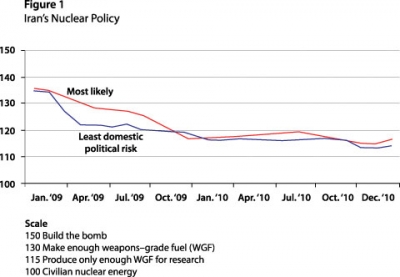
The red line shows us the most likely path. It reflects an analysis of eighty-seven decision makers in Iran, and a vast number of outside influencers trying to pressure Iran into changing its behavior, including various players from the United States, Egypt, Saudi Arabia, Russia, the European Union, Japan, and so on. The blue line reflects the analysis assuming that the international environment left Iran to make its own internal decisions under its own domestic political pressures. That won’t happen, but you can see that the line comes down faster if Iran is not under international pressure, if it’s left to its own devices. But in any event, by the end of this year or the beginning of next year we will arrive at a stable, equilibrium outcome. It will not be what the United States would like, but the United States and a lot of other nations can probably live with it. Under this analysis, Iran will satisfy its national pride by making enough weapons-grade fuel through research to show that it knows how to make weapons-grade fuel, but it will not produce enough to actually build a bomb.
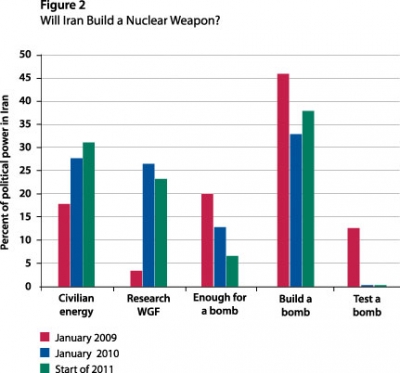
What will bring this about? Figure 2 shows the distribution of power in favor of civilian nuclear energy today and what that power bloc is predicted to be like by late 2010 or early 2011. Next, we see that just about nobody supports research on weapons-grade fuel today but that by 2011 it will be backed by a large bloc. Together, those two—research on fuel and civilian nuclear power—amount to the controlling influence in Iran. Moving to the right of the chart: today there are a bunch of people, Ahmadinejad for example, who would like not only to build a bomb but to test one. That power disappears completely by 2011. These guys are all shrinking; the power is drifting so that the outcome is going to be weapons-grade fuel.
And who are the future winners and losers in Iran? Look at figure 3. One group is plainly growing in power. Moreover, this analysis was conducted before the current economic crisis, which means that the blue line representing this group (the moneyed interests in Iran: bankers, oil people, and those gaining political clout) is probably going to get steeper. The mullahs, meanwhile, are isolating themselves, with the exception of the Quietist group of mullahs, not well known to Americans but who here appear to be growing in power. These are the ayatollahs, mostly based in Qum, who have great clout in the religious community, have been quiet on politics, and are going to be getting louder because they see Iran going in an unhealthy direction, one contrary to what Ayatollah Khomeini had in mind.
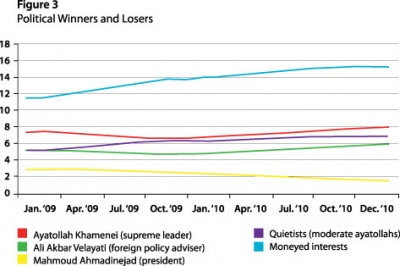
And look at Mr. Ahmadinejad! Notice two things: he’s getting weaker, and while he gets a lot of attention in the United States, he is not a major player in Iran. He’s on his way down.
THE FUTURE AS AN ENGINEERING PROBLEM
Not everything is predictable. The stock market, at least for me, is not predictable, but most complicated negotiations are. Health policy, education, environment, energy, litigation, mergers—all these complicated problems are predictable and amenable to this technological approach.
Being able to predict outcomes in these areas is important not just because you might run a hedge fund and make money, but because, by predicting people’s actions, you can engineer what they will do. And if you can engineer what they do, you can change the world. You can get a better result.
I would like to leave you with one thought, which for me is the dominant theme of this gathering and of how we should think about the world: When people say to you, “That’s impossible,” say back to them, “When you say ‘That’s impossible,’ you’re confusing it with ‘I don’t know how to do it.’ ”








